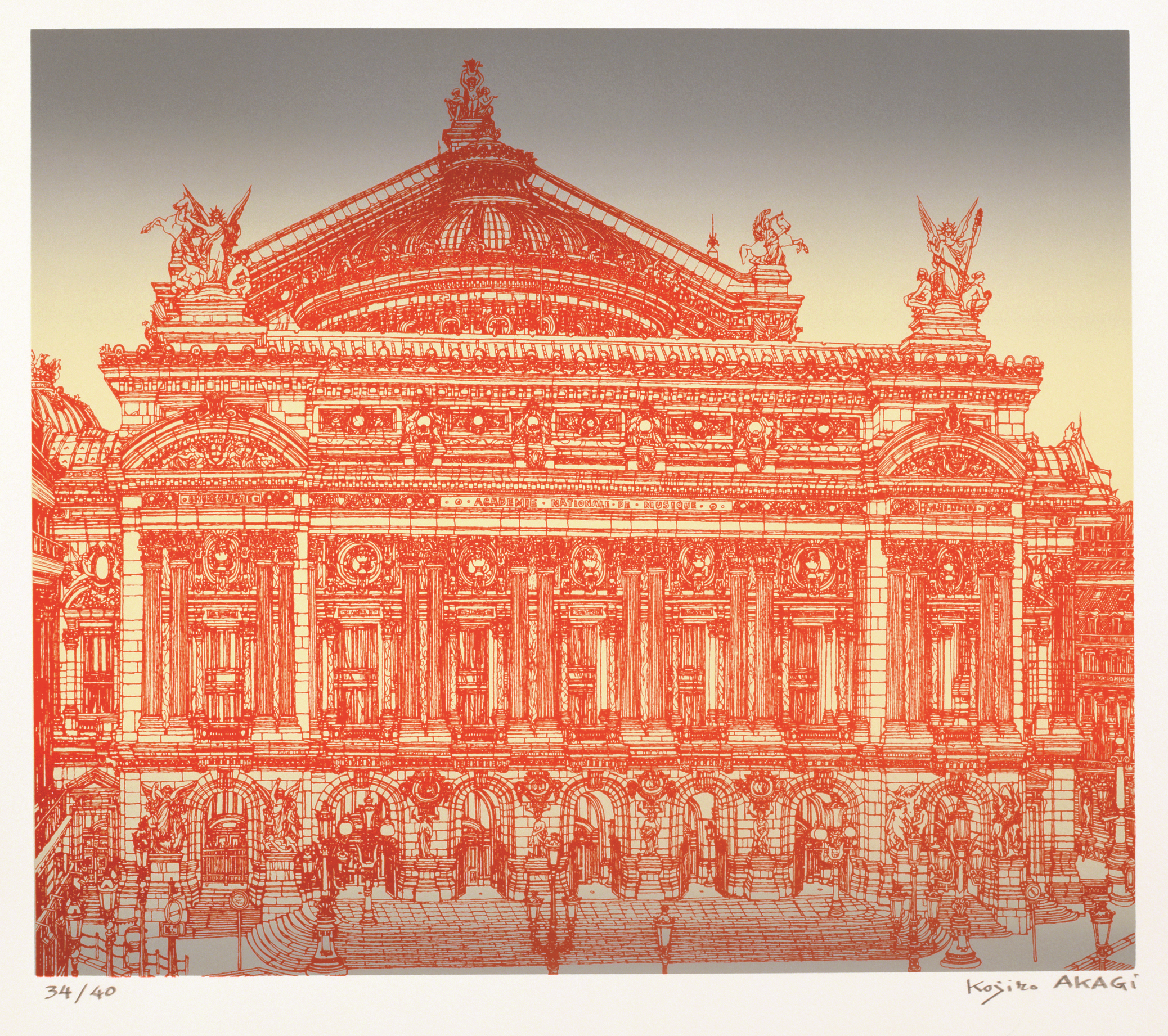L’Opéra de Paris / Paris Opera House / パリ・オペラ座
Dublin Core
Title
L’Opéra de Paris / Paris Opera House / パリ・オペラ座
Subject
Sérigraphie, Opéra
Description
Si on le nomme désormais l’Opéra Garnier pour ne pas le confondre avec l’Opéra-Comique ou l’Opéra Bastille, l’Opéra de Paris reste pour les Parisiens celui de la Place de l’Opéra. Conçu par l’architecte Charles Garnier et inauguré en 1875, il était, à l’époque, l’unique Opéra de Paris. Je considère la Place de l’Opéra comme le centre de Paris. Dans cette ville, chaque quartier dégage sa propre atmosphère. À l’est, ce sont les devantures des grossistes, des ateliers d’artisans et des logements ouvriers. En allant vers l’ouest, ce sont plutôt des bureaux et des habitations bourgeoises. Au nord, c’est le quartier animé de Montmartre avec ses étudiants. Et plus au sud, les professions libérales se sont installées. Le quartier japonais de Paris s’est développé autour de la rue Sainte Anne qui se situe à l’est de cet Opéra Garnier. C’est là que s’est développée la culture du râmen, soupe de nouilles à la japonaise dont les parisiens raffolent. Le dessin original de cette sérigraphie a été réalisé dans la salle d’exposition du magasin Moreau, un grossiste en tissus installé au 3e étage d’un bâtiment donnant sur la place de l’Opéra. À l’époque, les immeubles de cette avenue de l’Opéra étaient tous occupés par de grands marchands de tissu. Ils ont disparu dans les années 90. Déjà en 1969, les tailleurs commençaient à fermer boutique, puis ce fut le tour des magasins de prêt-à-porter, et désormais, les grossistes en tissus sont remplacés par des bureaux.
It is formally known as Palais Garnier in order to differentiate it from the Opera Comique and the new Opéra de la Bastille. When a new opera house, designed by Garnier, was opened in 1875, it was the only “Opera” and so literally I think it is the centre of Paris. There are wholesalers, small handicraft shops and workers’ housing areas in the east. In the west there are offices and luxury bourgeois housing. Clearly residential segregation can be seen. In the north is the entertainment district of Montmartre and in the south there is a totally different atmosphere with a student town and freelance shops. Japanese town in Paris is located on the street to the east of this opera house and it continues towards the south. There are lot of ramen (Chinese noodles in soup) shops along the street.This serigraph was drawn in a showroom of a woollen fabric wholesaler owned by Moreau, located on the 4th floor of the building opposite the Opera square. The main street of Opera used to be occupied by the offices of fabric wholesalers, although they all disappeared in 1990s. After the tailoring shops were gone in the 1960s, ready-to-wear clothing came in. Gradually shops started to do business directly with fabric makers and the producers so, one by one, the wholesalers on this street closed down. As a result the unoccupied spaces were taken up by offices.
今では正確にはオペラ・ガルニエと呼ぶ。オペラ・コミック座があるし、バスチーユ広場に新オペラ座も誕生しているからである。一八七五年に杮落とし(こけらおとし)の行われた、ガルニエ設計のオペラ座が、「オペラ」と呼べば昔はここだけだった。そして文字通り、ここがパリの中心だと思う。東の方に行くと、問屋街とか、小さな手工業、労働者の住宅となって行くし、西は事務所とか、高級ブルジョア住宅街とはっきり住み分けがされている。北は歓楽街のモンマルトル、南は自由業、学生街、空気や雰囲気が変わるのである。パリの日本人街は、丁度このオペラ座から、一本だけ東の通りを中心に、ずっと南に伸びていて、ラーメン屋文化が目立っている。 この版画は、ちょうど広場の真向かいの建物の四階にあった、モローさんという毛織物問屋さんの、展示室から描かせてもらった。一九九〇年代に消えてしまったが、昔のオペラ大通りは布地の大きな問屋さんの事務所で、全て占められていたものだった。御仕立て洋裁店が一九六〇年代に消え、プレタポルテ既製服の時代になって、この界隈を占めていた問屋さんも、産地やメーカーから直接取引の時代になり、一軒々々消えて、事務所になって行った。
パリに観光に訪れて、ガルニエ・オペラ広場に立たない人はないだろう。正面石段から眺めて、右手斜め遠くに青銅色の高い塔が見えるのがこのバンドーム広場である。ルイ14世が命令して作らせた広場だから、オペラ座より200年近くも古い。現在では高級宝飾店や時計店がこの広場を貫く通りに軒を並べ、ここに店を持っていると一級品の格式に思われる。日本では養殖真珠のミキモトとコム・デ・ギャルソンが、広場に店を出している。6番地の建物の2階の窓から、紹介してくれる人があって描いた。左向かいはリッツホテル、ダイアナ元皇太子妃も最期に泊まっていた有名ホテルである。
パリに観光に訪れて、ガルニエ・オペラ広場に立たない人はないだろう。正面石段から眺めて、右手斜め遠くに青銅色の高い塔が見えるのがこのバンドーム広場である。ルイ14世が命令して作らせた広場だから、オペラ座より200年近くも古い。現在では高級宝飾店や時計店がこの広場を貫く通りに軒を並べ、ここに店を持っていると一級品の格式に思われる。日本では養殖真珠のミキモトとコム・デ・ギャルソンが、広場に店を出している。6番地の建物の2階の窓から、紹介してくれる人があって描いた。左向かいはリッツホテル、ダイアナ元皇太子妃も最期に泊まっていた有名ホテルである。
Creator
Kojiro Akagi (1934-2021)
Date
20 mai 1975 / 20 May 1975
Rights
Fonds de dotation Kojiro AKAGI
Format
Sérigraphie, Atelier Del Arco, 40 tirages + 10 E.A. romain, sur papier Arches 50 x 65 cm.
Type
Sérigraphie
Tags
Citation
Kojiro Akagi (1934-2021), “L’Opéra de Paris / Paris Opera House / パリ・オペラ座,” Kojiro Akagi - Fonds de dotation Kojiro AKAGI , accessed October 15, 2025, https://kojiroakagi.com/gallery/items/show/36.

